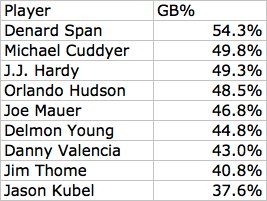ALCS Game 3 Preview: Yankees
Starting pitching has not been kind to the Yankees in this series’ first two games. The Yankees offense let CC Sabathia off the hook by mounting an eighth-inning comeback, but they had no such luck with Phil Hughes on the mound. The offense went 1 for 11 with runners in scoring position, including 0 for 5 as they tried to mount a comeback in the later innings. Tonight they’ll turn to their longest tenured starter, Andy Pettitte, for a victory in Game 3.
Pettitte has a longer postseason resume than any other active pitcher, and has pitched more postseason innings than the entire Rangers roster combined. Throughout that 256-inning history Pettitte has had his ups and downs, but ever since he underwent reconstructive elbow surgery in 2004 he has been lights out. In 11 starts he has thrown 69.1 innings (6.1 IP/start) and has allowed 26 runs on 50 strikeouts and 20 walks. In only two instances has he allowed more than three runs. This stands in contrast to his earlier postseason record, which was littered with bombs and brilliance rather than steady, solid performances.
The current Rangers roster has hit Pettitte well, a .308/.373/.462 line in 162 PA. That lineup also hits finesse and average pitchers better than power pitchers, and hits average flyball/groundball guys better as well. None of those bodes well for Pettitte. None of it is particularly predictive — as we saw on Saturday, sometimes pitchers will fare well against hitters who would normally hit them. But if Yankees fans are keeping a Concerned Meter, the dial has to be turned up to a decent degree. That could go up a bit after we look at the Rangers’ starters career numbers against left-handed pitching.
Elvis Andrus: .318 wOBA
Michael Young: .363
Josh Hamilton: .410
Vladimir Guerrero: .413
Nelson Cruz: .339
Ian Kinsler: .389
Jeff Francoeur : .346
Bengie Molina: .353
Jorge Cantu: .330
Some of these numbers don’t necessarily reflect current talent levels — Cruz appears a bit low while Molina is way high — but they still don’t look encouraging. The Rangers have hit left-handed pitching well. The saving grace for the Yankees is that fly balls tend to die out in left-center.
The current Yankees hitters have faced Cliff Lee 308 times in the regular season and have hit him decently well, .280/.329/.482, which is quite a bit better than Lee’s career line of .260/.307/.405. There are, of course, two different Cliff Lees. After his 2007 demotion to the minors he turned things around and become one of the game’s most dominant pitchers. You can read about the full New York – Cliff Lee history on River Ave. Blues.
While anything can happen in any given game, the match-ups in this one appear to favor Texas. The one thing the Yankees have on their side is experience, and we don’t know what that counts for, if it counts for anything at all. But for eight of the 10 starters tonight, it’s the first postseason trip to Yankee Stadium. The Rangers have to be thankful that the one of the three that has been there is Cliff Lee.


















